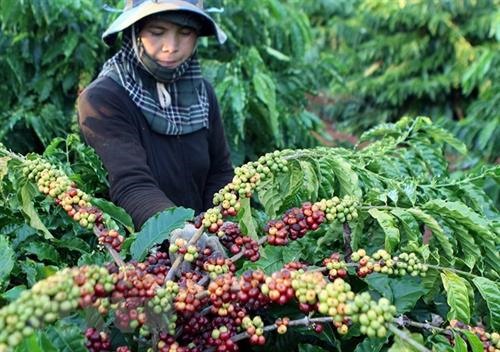 Society
Society

Most Robusta coffee areas replaced in recent years in the Tây Nguyên (Central Highlands) provinces have yielded more than 4 tonnes per ha, up 1.65 times compared to other coffee areas, according to the Western Highlands Agro-Forestry Scientific and Technical Institute.
 |
| Harvesting coffee in Đắk Lắk Province. – VNA/VNS Photo Dương Giang |
HCM CITY – Most Robusta coffee areas replaced in recent years in the Tây Nguyên (Central Highlands) provinces have yielded more than four tonnes per ha, up 1.65 times compared to other coffee areas, according to the Western Highlands Agro-Forestry Scientific and Technical Institute.
In key coffee planting areas in Lâm Đồng and Đắk Lắk provinces, many coffee orchards with replaced trees have an average yield between 4-7 tonnes per ha.
Trần Văn Ngoạn replanted his coffee orchard of more than 22 years in Ea Tu Commune in Đắk Lắk Province’s Buôn Ma Thuột City in 2013.
In the 2016-17 coffee season, Ngoạn harvested 5 tonnes of coffee per ha.
In Ea Tu Commune, which has nearly 1,500ha of coffee, the largest area in Buôn Ma Thuột, about half of the coffee areas were planted before 1990, according to the commune’s Farmers’ Association.
To improve coffee yield, the Ea Tu Commune People’s Committee has supported farmers to replace old coffee orchards by providing soft loans and farming techniques since 2014.
Nguyễn Quang An, chairman of the commune’s Farmers’ Association, said the Ea Tu Commune People’s Committee will support farmers to replant old coffee orchards by 2025.
Coffee farmers in the Tây Nguyên provinces have chosen high yield and quality Robusta coffee varieties such as TR4, TR9, TR11, TR12, TR 13 and TRS1 to replant old coffee trees in recent years.
The varieties are resistant to coffee leaf rust, a fungus disease which can cause loss of leaves and ability to produce beans.
Coffee varieties like TR4 and TR5 have harvest time in January and February when the Central Highlands provinces are in the dry season, a favourable condition for harvesting and processing coffee.
Nguyễn Thị Nhung, who replanted her 1ha of old coffee trees in Kon Tum Province’s Đắk Hà District in 2016, said she would harvest the first crop of the replanted coffee this year and expected to have a high yield.
“My old coffee orchard was more than 20 years old and had low yield, so in years when there was poor harvest, my family did not have a profit,” she said.
The province’s Agriculture Extension Centre offered support for all coffee seedlings of TR4 varieties, and 50 per cent of the cost of fertiliser and pesticides, as well as farming techniques for replacing old coffee trees, she said.
“With quality coffee seedlings and the instructions of agricultural officials about farming techniques, my replanted coffee orchard is growing well,” she said.
Đắk Hà District is Kon Tum’s largest coffee planting area, but most coffee orchards are 20-30 years old and have low yield.
Since 2016, the province’s Agriculture Extension Centre has supported farmers in Đăk Hà to replant nearly 70 old coffee orchards with new coffee varieties like TR4 and TRS1, according to Đoàn Năng Rường, director of the centre.
The replanted coffee orchards are developing well and expect to have a good yield, he said.
In addition, farmers have also intercropped other fruit trees in coffee orchards to create shade for replanted or grafted coffee trees and improve income.
Tây Nguyên provinces, which account for the largest coffee planting area in the country, have also set up coffee nurseries to supply high quality seedlings for coffee farmers and companies.
Form 2014-20, the provinces plan to replant 90,000ha of old coffee trees and use grafts to upgrade 30,000 ha of old coffee trees.
The provinces have replanted and grafted more than 98,210ha so far, according to the Ministry of Agriculture and Rural Development’s Plant Cultivation Department. – VNS




